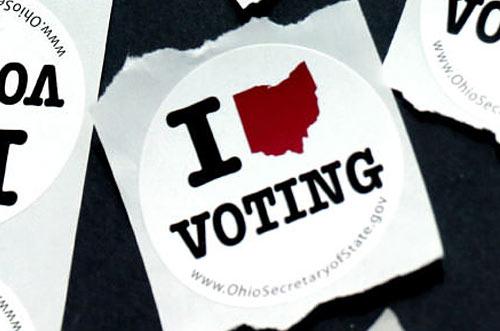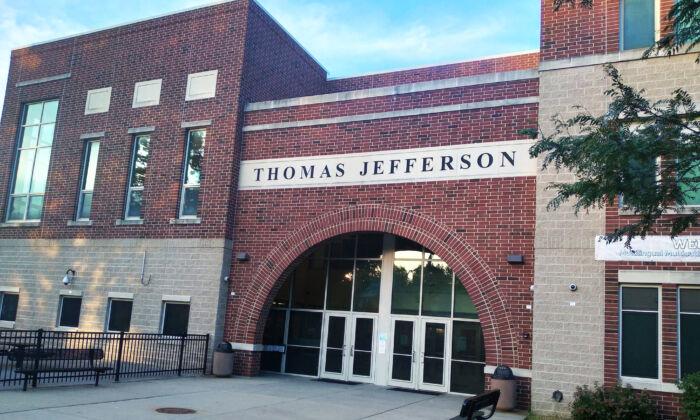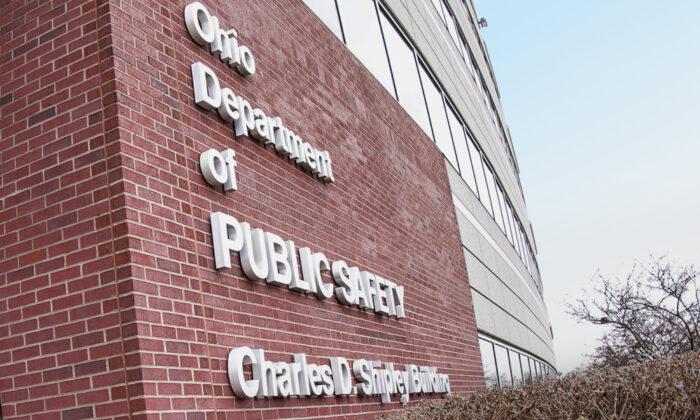The line in the sand has been drawn, so to speak, between the two candidates for Ohio Governor who will be facing off on the Nov. 8 general election.
It’s incumbent Republican Mike DeWine vs. challenger Democrat Nan Whaley.
DeWine received the most votes in the primary with 514,374, and Whaley was second with 326,329, according to unofficial results from the Ohio Secretary of State’s Office.
Jim Renacci was third with 299,515 votes.
The results will be certified and deemed official on May 27, according to information from officials.
DeWine, 75, the oldest in the race, will be facing the youngest with Whaley being 46.
The outcome of the election will give DeWine and Lt. Gov. Jon Husted a chance to “continue the work they started,” or Whaley a chance of changing the state altogether.

“We want to continue and finish the work we started,” DeWine said during his State of the State speech in March and the night he won the GOP nomination in the primary.
Whaley and her running mate, Cheryl Stephens, received 65 percent of the Democratic vote to defeat former Cincinnati mayor John Cranley’s 35 percent (175,771). She won 80 of 88 Ohio counties, including Butler County which covers Cincinnati.
DeWine won 64 counties, while another challenger Joe Blystone won 22 counties.
“Ohio is at a crossroads. We need a governor who is tough enough to stand up for what’s right and build a state where we can all thrive,” Whaley said.
The sentiments of Kathy Wyenandt, vice chairman of the Butler County Democratic Party, echoed Whaley’s.
Whaley also won in Butler County in the usually-conservative southwest Ohio, that neighbors Hamilton County near Cincinnati.

“We were just lucky to have two very good and strong Democratic candidates,” Wyenandt told The Epoch Times.
“It was a tough decision for a lot of people because many of them personally know John (Cranley) and Nan Whaley down here. I think people are ready for a refreshing change and common-sense leadership, and we believe Nan Whaley brings that to the table.
“People are getting tired of the corruption and the extreme one-party rule,” Wyenandt added. “We’re ready for a governor that works for the people and that is not beholden to special interest groups.”
For the first time in 44 years, an incumbent governor faced a challenger in the primary. In DeWine’s case, it was three—Blystone, Renacci, and Ron Hood.
Whaley was elected as Dayton’s mayor in 2013, running unopposed in 2017—the first time in city history that a mayoral race ran uncontested. Before being elected mayor, Whaley served on Dayton’s City Commission.
She has been outspoken against what she believes is corruption in state politics.
In Ohio’s past 50 years, there have been six Republican governors and three Democrat governors.
DeWine defeated Democrat Richard Cordray by 50.4 percent to 46.7 percent to win the governor’s race in the 2018 election. It was the largest voter turnout in Ohio for a governor’s race, according to the secretary of state’s office.
DeWine has held political office since he was in his late 20s. He first served as Greene County Prosecutor, before becoming a State Senator in 1980, then serving in the U.S. House of Representatives in 1982.
Eight years later, DeWine was elected lieutenant governor, in 1994 to the U.S. Senate, and 2010 to Ohio attorney general before the governor in 2018.
The issues, which have been described as emotional and very partisan by voters, are a big part of the stark differences that separate the two in what has been called a complicated if not contentious relationship between them.
DeWine and Whaley each have their point of view on key issues facing the rustbelt state in the Heartland—the economy, need for jobs and major development, abortion, immigration, crime, and gun control.
In addition, political experts have said that the Democrats are facing heavy headwinds going into the November mid-term elections. There’s inflation, skyrocketing gas prices, and the lack of name recognition on Democratic ballots throughout several states.
“Even though the legislature and I have not always agreed on everything, this legislature has been very supportive of the major initiatives we have placed in front of them,” DeWine said during his State of the State speech.
The night of his primary victory, DeWine said he and Husted simply ran on their record, and they defended that record.
“We work to make sure that every Ohioan has the opportunity to live up to their God-given potential,” DeWine said. “People vote for their future. We have a fiscally-sound administration.
Where They Stand on Issues
Abortion: DeWine is pro-life; Whaley is pro-choice.DeWine has been known to be liberal in some decisions and called a RINO (Republican in Name Only) for doing so, attracting the support of Democrats and several Independents. But some constituents believe some of DeWine’s far-right and somewhat liberal decisions are what could ultimately help him earn re-election.
In April 2019, DeWine signed the “Heartbeat Bill” to help protect unborn babies against abortion when a heartbeat is first detected at the six-week mark.
In December, DeWine also signed the “Born Alive Bill,” which requires abortion clinics to perform emergency procedures on a newborn. Doctors would need to care for the health and life of an infant born alive after a botched abortion. Physicians would also have to fill out a “child survival form” or face a third-degree felony.
Other Issues For Governor’s Race
Eliminating transgenderism, Critical Race Theory and social emotion learning courses from public schools remain a hot-button issue in Ohio.The topics receive the strongest reaction from the crowd when former president Donald Trump brought them up at the rally in late April.
As the state is facing an onslaught of CRT and cancel culture being pushed in its public schools amid the growing concern of parents, DeWine would not say whether he would put an executive order in place to stop it.
DeWine stepped back from banning boys from playing girls’ sports and the cancel culture movement that is planning to remove the names of American patriots including Thomas Jefferson, Patrick Henry, and John Marshall from at least seven Cleveland Metropolitan Schools.
In fact, DeWine blocked a proposed amendment that would have blocked boys from playing girls’ sports from a sports-related bill.
Many of his constituents were not happy with the way he handled the pandemic in the way of lockdowns, resulting in permanent closures of restaurants (more than 3,500 closed in Ohio), salons, and barbershops.
However, much to the surprise of many out-of-work restaurant owners, DeWine received the endorsement of the Ohio Restaurant Association.
DeWine’s administration is taking steps to bolster the state’s food supply and becoming more independent from foreign or outside sources.
Because of food shortages and supply chain issues that still are lingering, DeWine and Husted recently announced an additional $18 million in grants through the Ohio Department of Agriculture for state beef and poultry processors to help about 100 independent plants.
In February, DeWine’s office announced the initial $10 million in grants for 40 beef and poultry processors. The second half of the grants were distributed the first week of May.
The grants can be up to $250,000 for an individual business.
They can go toward the expansion of plants, purchase of new equipment, training and certification costs, and hiring of employees to better contain meat costs for the consumers and better handle the increased demand and need to get away from the dependence on foreign food products.
Throughout the campaign, Whaley visited and spoke throughout Democratic strongholds in northeast Ohio, becoming known in large Democratic circles and gaining the endorsements of longtime U.S. Senator Sherrod Brown.
Whaley contends that DeWine has broken his campaign promises.
“We have made promises, and we have kept those promises,” DeWine said. “This is our time in history.”

On development that is planned to further develop the northern suburbs of Columbus, DeWine and Intel officials announced plans for a $20 billion computer microchip plant project earlier this year in the rural area of New Albany.
The project is expected to spur more development in housing and support businesses for Intel.
DeWine also said of the Intel project, “This is about American jobs, it’s about national security. We must make more products in the United States.”
Ohio is within one day’s drive of 60 percent of the U.S. population and also has 14 public universities, 74 private colleges, and 23 community colleges to draw working talent from, DeWine said.
There currently are 140 businesses that support Intel in Ohio, and the state plans to add more.
The Democratic stronghold of Lorain County between Cleveland and Sandusky could be considered Ground Zero for the 2022 mid-term elections.
The area has suffered from a loss of jobs, the lack of change over decades in deteriorated neighborhoods, and empty storefronts are obvious throughout its downtowns.
Joel Arredondo, a 16-year Democratic councilman on Lorain City Council, told The Epoch Times he feels positive about Whaley’s chances.

“I think we have a shot, it’s just all about getting out the vote,” he said of Nan Whaley’s chances of becoming governor.
“When she came to Lorain County and spoke, I liked what she said. I believe she’s here for the voters and is listening to what they have to say.”
“She’s a woman, and there’s still a big ”Me Too“ movement right now,” Joel Arredondo added. “I think that’s going to help her and the party. We'll just have to see how dissatisfied the voters are, and see if they want change.”
The council currently has an 11-member, all-Democratic council, but DeWine received 52 percent of the votes in Lorain county, 4 percent better than what he received in the state.
There were about 26,000 Republicans who turned out to vote for the county in the primary, and about 18,000 Democrats, a pretty positive sign, Lorain County Republican Party chairman David Arredondo told The Epoch Times.
David Arredondo is Joel Arredondo’s brother.
The thoughts of David Arredondo differed from his brother about Whaley’s chances.

“Hopefully, we’re picking up voters that are walking away from the Democratic Party because they are getting too extreme.”
“The Dems have nothing to run on. It’s all about the economy, and they can’t talk about that. Look at inflation, look at the price of gas.
“The governor and the attorney general could make a good case about the crime problem in our state in urban areas that are run by Democrats.”
David Arredondo was returning from a family trip to Los Angeles on May 10 and was quick to note that gas there was $6.50 a gallon.
He believes the outcome in November will be a positive one for DeWine.
“DeWine’s numbers got better on election night of the primary. The governor is pretty popular with Democrats and Independents. The Democrats have no bench. None of their candidates have name recognition.”
David Arredondo went on to say that there are basically two types of Republican voters, the MAGA group, which is a little more loud and active, and the mainstream establishment that keeps voting GOP candidates into the State House and Senate.
“The Democrats are in a state of hurt,” he said.




